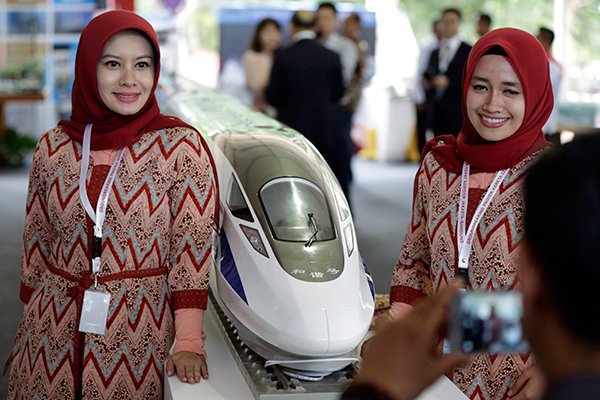Infrastructure helps regional integration

Two Indonesian women pose for a photo in front of a model of China's high-speed train in Walini, West Java province, on Jan 21, 2016 to mark the launch of the Jakarta-Bandung high-speed railway project. [Photo/Xinhua]
Overall investment needed for projects may reach $3.26 trillion Infrastructure connectivity is a focus of both the Belt and Road Initiative and the G20 Leaders Summit because of its significance for boosting economic growth and promoting prosperity.
In the communiqué issued after the G20 Finance Ministers and Central Bank Governors Meeting held in Chengdu, Sichuan province on July 23-24, a global infrastructure connectivity alliance was planned to be launched to enhance the synergy and cooperation among various infrastructure connectivity programs in a holistic way.
As the communiqué said, greater interconnectivity is a defining demand of the 21st century global economy and the key to promoting sustainable development and shared prosperity.
A core aim of the Belt and Road Initiative is to achieve connectivity in five aspects, including policy, infrastructure, trade, financing and peoples.
Infrastructure connectivity is a priority area for the Belt and Road Initiative, because it directly relates to trade costs and so will influence a region's trade level.
The development of many countries along the Belt and Road routes is restricted by their underdeveloped infrastructure due to geographic factors and their low financing capacity. That means there is an urgent demand for infrastructure construction in these countries, as well as tremendous market potential to be tapped by improving the infrastructure connectivity along the Belt and Road.
The Chinese consultancy company SWS Research Co. estimated in a report on the Belt and Road Initiative that the overall investment needed for infrastructure construction in core countries along the Belt and Road is about $3.26 trillion.
"Since the launch of the Belt and Road Initiative by July 2016, the total value of the contract projects that China has signed with countries along the routes is $279 billion," said Shen Danyang, a Ministry of Commerce spokesman, at a media briefing on Aug 17.
A series of infrastructure projects in countries along the routes, mainly ports, railways, highways, airports and telecommunication networks, have been launched recently.
The China-Pakistan Economic Corridor, which has been called "the first movement of the symphony of the Belt and Road Initiative" by Wang Yi, China's foreign minister, is the demonstration project of the six economic corridors of the Belt and Road Initiative and the first milestone in the implementation of the initiative.
"Connectivity, linkage and interdependence between China and Pakistan will all increase through the initiative," said Shaukat Aziz, former prime minister of Pakistan, in an exclusive interview with China Daily in July.
Meanwhile, China's technological and management advantage in transportation infrastructure construction, especially high-speed railways, can effectively meet demands of the countries along the routes.
Construction of the China-Thailand railway within the Trans-Asia Railway network and Jakarta-Bandung high-speed railway in Indonesia have successively started, and a batch of highways in countries along the routes have also been launched. A comprehensive regional traffic integration network is gradually forming shape.
Chu Yin, a researcher on the Belt and Road Initiative at the University of International Relations, states that there are three major regions for infrastructure construction along the Belt and Road routes, namely Southeast Asia, South-Central Asia and Africa.
"Infrastructure construction in these areas along the routes will be decisive in promoting regional integration," Chu said.

 Print
Print Mail
Mail
 20 Cultural Symbols
20 Cultural Symbols Why Zhejiang
Why Zhejiang Experiencing high-tech products at WIC
Experiencing high-tech products at WIC Zhejiang Release
Zhejiang Release Zhejiang News
Zhejiang News